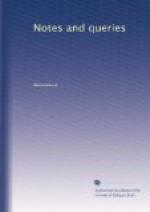1. A coin of the size of Roman 1 B., of the province of Macedonia Prima.—Obv. A female head, with symbols behind, and a rich floriated edge: Rev. A club within an oaken garland: Legend in the field, [Greek: MAKEDONON PROTES].
The type is illustrated by Dr. Horne, in his Introduction to the Study of the Bible, in explanation of Acts, xvi. 11, 12. The specimen in my possession is in lead, finely struck, and therefore not a cast, and in all respects equal in point of sharpness and execution to the silver of the same size and type in the British Museum; and was dug up by a labourer at Chesterton, near Cambridge. How is the metal of which my specimen is composed to be accounted for?
2. A 3 B. coin apparently by the portrait of Tiberius.—Legend defaced: Rev. The type known by collectors as the altar of Lyons: Ex. (ROM)AE ET AV(G.)
3. A 3 B. of Herennia Estruscilla.—Rev. The usual seated figure of Pudicitia; and the Legend, PVDICITIA AVG.
According to Col. Smyth, Akermann, and other authorities, no third brass of this empress exists; but the specimen before me has been decided as undoubtedly genuine by many competent judges.
4. A 3 B. coin of the Emperor Macrinus, struck in some of the provinces.—Obv. A bearded portrait of the emperor: Leg., AVT. K.M.O.C.C. MAKPINOC: Rev. An archaic S.C. in a laurel garland, above L and beneath C. I am anxious to know to what locality I may ascribe this coin, as I have not been able to find it described.
E.S.T.
* * * * *
QUERIES PROPOSED, NO. 2.
When reflecting on my various pen-and-ink skirmishes, I have sometimes half-resolved to avoid controversy. The resolution would have been unwise; for silence, on many occasions, would be a dereliction of those duties which we owe to ourselves and the public.
The halcyon days, so much desired, may be far distant! I have to comment, elsewhere, on certain parts of the Report of the commissioners on the British Museum—which I hope to do firmly, yet respectfully; and on the evidence of Mr. Panizzi—in which task I must not disappoint his just expectations. I have also to propose a query on the blunder of Malone—to which I give precedence, as it relates to Shakspeare.
The query is—have I “mistaken the whole affair”? A few short paragraphs may enable others to decide.
1. The question at issue arose, I presume to say, out of the statement of Mr. Jebb. I never quoted the Irish edition. If C. can prove that Malone superintended it, he may fairly tax me with a violation of my new canon of criticism—not otherwise. What says Mr. James Boswell on that point? I must borrow his precise words: “The only edition for which Mr. Malone can be considered as responsible [is] his own in 1790.” [Plays and poems of W.S. 1821, i. xxxiii.]




